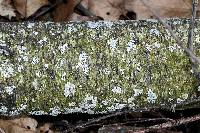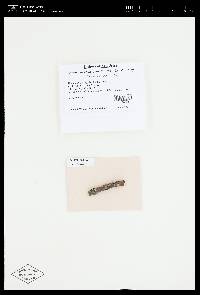
Consortium of Lichen Herbaria
- building a Global Consortium of Bryophytes and Lichens as keystones of cryptobiotic communities -
- Home
- Search
- Images
- Species Checklists
- US States: O-Z >
- US National Parks
- Central America
- South America
- US National Parks
- Southern Subpolar Region
|
|
|
|
Family: Caliciaceae
[Buellia myriocarpa var. polyspora Willey, moreBuellia polyspora (Will.) Vain., Buellia punctata var. polyspora (Willey) Fink] |
Thompson, J., 1997. American Arctic Lichens: The Microlichens. As this species differs from B. punctata only in the number of spores in the ascus, 12-24 instead of 8, and the pale interior of the exciple instead of entirely dark, the description of B. punctata should be consulted. B. polyspora ranges widely in the eastern United States from Maine to Florida and has disjunct records in Alaska, at least as currently known. This distribution pattern is reminiscent of that of Baeo-myces rose us. It has also been reported from Brazil and the West Indies. Nash, T.H., Ryan, B.D., Gries, C., Bungartz, F., (eds.) 2007. Lichen Flora of the Greater Sonoran Desert Region. Vol 3. Thallus: crustose, indistinct to granular, becoming irregularly subsquamulose if well developed, thin, discontinuous; prothallus: absent surface: pale brown to grayish brown, dull, epruinose, phenocorticate, esorediate medulla: white, lacking calcium oxalate (H2SO4-) Apothecia: lecideine; (0.1-)0.2-0.3(-0.4) mm in diam., soon sessile margin: black or brownish black, thin, rarely persistent, soon excluded disc: black or brownish black, epruinose, plane, soon becoming convex proper exciple: narrow, poorly differentiated, aethalea-type, inner excipular hyphae narrow, hyaline, prosoplectenchymatous (textura oblita), often reduced, similar in structure and orientation to the paraphyses, transient with the pale yellowish brown hypothecium (cf. elachista-brown, textura intricata), outer excipular hyphae parallel, moderately swollen (textura oblita) weakly to strongly carbonized with various amounts of a brown pigment (cf. elachista-brown, HNO3-) epihymenium: brown, pigmentation continuous with the outer exciple (HNO3-) hymenium: hyaline, not inspersed with oil droplets; paraphyses: simple to moderately branched, apically swollen, with a brown pigment cap (cf. elachista-brown) asci: clavate, Bacidia-type, (8-)16(32)-spored ascospores: soon brown, 1-septate, oblong to ellipsoid, not constricted, with obtuse ends, not curved, (8-)8.4-[9.3]-10.2(-11.2) x (3-)3.2-[3.7]-4.2(-5) µm (n=25); proper septum: narrow, not thickening during spore ontogeny (Buellia-type); ornamentation: not visible in DIC Pycnidia: rare, globose, unilocular, at maturity lined with short barely branched conidiophores; ontogeny similar to the Roccella-type conidiogenous cells: terminal, not intercalary (conidiophoretype III) conidia: filiform, 14.5-30 x 0.5-1 µm (n=30) Spot tests: K- (rarely K+ yellow), P-, C- fluorescence: UV- (pale) iodine reaction: medulla non-amyloid Secondary metabolites: no substances, or rarely with atranorin. Substrate and ecology: on bark, rarely on wood World distribution: fairly common in the eastern and southeastern USA Sonoran distribution: Arizona (Santa Catalina Mountains) and Sinaloa (south of the Sonoran region). Notes: Buellia polyspora was placed into Amandinea by Sheard and May (1997) because of its filiform conidia. Buellia coniops (Wahlenb.) Th. Fr., the type of Amandinea is an arctic-alpine species absent from the Sonoran Region. It shares some characters with B. polyspora, which suggest that the species may belong into a smaller core group that could eventually be accepted as Amandinea s.str. Because this genus is currently not well supported (Bungartz et al. 2004b), the species is retained here within Buellia. Buellia polyspora, though inconspicuous, is well characterized by its small spores and polysporous asci. In squash preparations or even hand sections, asci easily break apart and accurate spore counts are therefore sometimes difficult. Most asci typically have 16 spores, but some have 32 spores. Asci with only 8 spores can also be observed very occasionally within sections that otherwise have predominantly 16-spored asci. In the Sonoran Region, only Buellia schaereri has similarly small ascospores, but the latter species never has polysporous asci, and it has bacilliform instead of filiform conidia found in B. polyspora. |
|
|
|
Powered by Symbiota







































































































